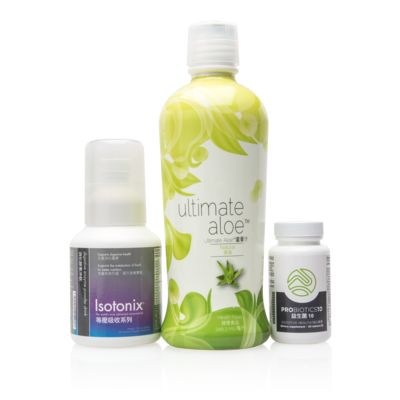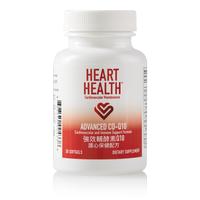認識更好的自己!

消化保健組合
產品代號(sku) HK6491
HK$915.00 HKD HK$823.00 HKD 你省下: HK$92.00 HKD (10.0%)
HK$16.46 HKD 現金回贈
此產品符合免運費或優惠運費資格。 了解更多資訊
益處

- 有助紓緩偶發性胃部不適
- 提供益菌,有助維持細菌平衡在理想狀態
- 提供可促進營養素吸收的酵素及益菌
- 支援消化健康
- 有助支援免疫健康
- 或有助平衡消化系統不適
- 支援腸道健康
- 支援食物分解以取得最佳的營養素
- 節省10%!
詳細資料
現今加工食品及快餐盛行,人如其食。不良的飲食習慣讓人體分解食物、吸收營養及排毒的工作變得更加吃力。維持消化及免疫系統的健康,有賴理想的細菌平衡及最大的營養吸收。
消化保健組合所包含的產品透過協同效應去支援消化系統的舒適度、規律性、免疫功能、適當的營養吸收及促進腸道益菌的平衡。此外,與分開購買單項產品相比,購買消化保健組合可以節省10%的金錢。
身體需要消化酵素,以適當地吸收及使用食物裡的營養素。缺乏消化酵素消化系統額外增加消化系統的壓力,導致消化不良。身體製造消化酵素的能力會隨年齡增長而減少。
Isotonix®消化酵素沖飲 是等滲透的營養補充品,補充重要消化酵素和益生菌,有助維持消化健康。
益生菌10含10種精心挑選的益生菌品種,每一種都對於維持細菌平衡和消化系統健康有獨特功效。消化系統是免疫防禦的首要部分,佔身體免疫系統70%。維持細菌平衡是保持消化道健康的首要條件。消化道存在400-500種不同的細菌,這些細菌包括益菌(益生菌)及害菌。
確保益菌的數量多於害菌,是維持理想消化及免疫健康重要的部份。原本於消化道內的益生菌種類非常多,因此不能只補充其中一種,必須補充多種益生菌以獲得最全面的好處。
Ultimate Aloe™蘆薈汁來自天然蘆薈葉,透過獨有萃取過程不但能保留蘆薈天然品質,同時補充酵素和移除不需要的成分,例如:蘆薈和大黃素,此成分可能會導致消化系統不適。Ultimate Aloe™蘆薈汁提供卓越的效果,深得顧客信賴。根據研究指出,口服蘆薈有助促進消化及支援健康免疫系統。
成分
Ultimate Aloe 蘆薈汁
Ultimate Aloe由蘆薈葉製成,透過獨家的製造過程移除蘆薈素與大黃素,同時保留高水平的的多醣體。蘆薈所含的多醣體已證實對人體健康有許多好處。經國際蘆薈科學協會(IASC)認證,證實此產品的蘆薈含量及純度均達到標準。蘆薈含有維他命、礦物質、三酸甘油酯、碳水化合物、氨基酸、酵素及水分。蘆薈含有的維他命包括B1、B2、B3、B12、膽鹼、葉酸、維他命C與β-胡蘿蔔素(維他命A原),這幾種維他命對良好的健康和主要酵素合成都不可或缺。蘆薈已獲證實含有多種對人體健康所需的礦物質。蘆薈含有的礦物質包括鈣、鎂、鉀、氯化物、鐵、鋅、錳、銅、鉻、硫、硼、矽、磷及鈉。這些礦物質對人體的發育成長和身體機能極為重要。蘆薈也含有必需的三酸甘油酯,包括脂肪、油脂及蠟。這幾種脂質負責輸送脂溶性維他命,並且提供人體成長與整體健康必需的脂肪酸。人體健康所需的22種氨基酸中,蘆薈含有其中20種,當中9種無法於人體製造,故此必須透過其他來源攝取。而蘆薈則包含這9種必要氨基酸。蘆薈也含有重要酵素,這些酵素可觸發維他命、礦物質及荷爾蒙的化學反應,是維持身體正常功能所不可缺少的物質。
益生菌 10 :
臨床研究顯示,益生菌可支援腸道健康,並有其他多個好處。益生菌有助維持腸胃道內細菌的健康平衡,而由於我們經常進食加工食品,益生菌對我們的飲食就日益重要。加工食品和其他多項因素或會對腸胃道的細菌平衡造成負面影響,而益生菌就有助對抗這些影響。
胚芽乳酸桿菌
研究顯示,胚芽乳酸桿菌可促進最理想的消化健康。胚芽乳酸桿菌與害菌爭奪營養,有助減少自然存在於人體的害菌,同時保留重要營養、抗氧化物和維他命。胚芽乳酸桿菌其中一項卓越的功能,就是製造離氨酸;離氨酸是必需氨基酸,為多種身體機能所需。
嗜乳酸桿菌
嗜乳酸桿菌是最廣獲研究和使用的益生菌之一, 為可製造乳酸的桿菌,對腸道健康有多種益處。嗜乳酸桿菌製造維他命K、乳糖酵素和抗微生物的物質,例如嗜酸乳菌素、嗜酸菌素、乳酸殺菌素及細菌素。嗜乳酸桿菌具有多種功能,科學家發現,口服嗜乳酸桿菌有助維持消化道內的正常細菌平衡。研究顯示,嗜乳酸桿菌可支援腸道健康。嗜乳酸桿菌製造乳糖酵素,有助將乳糖分解成單糖,支援乳糖的代謝。
鼠李糖乳酸桿菌
鼠李糖乳酸桿菌有助平衡腸胃道的微生態, 是最廣獲研究的腸胃道細菌之一。 鼠李糖乳酸桿菌其中一個最大特點,是可抵抗胃部極酸環境,甚至在這環境下繁衍。研究顯示,鼠李糖乳酸桿菌有助維持胃壁完整。
唾液乳酸桿菌
唾液乳酸桿菌存在於口腔及小腸。研究顯示,它有助減少起碼五種形成牙菌膜的潛在害菌。唾液乳酸桿菌或有助支援腸道內的平衡。
乾酪乳酸桿菌
乾酪乳酸桿菌存在於牛奶、芝士及奶類製品, 與其他乳酸菌一樣會製造乳酸,並協助益菌形成菌落,有助紓緩偶發性腹瀉。乾酪乳酸桿菌於多種溫度和酸鹼度下均保持活躍,並自然存在於人類口腔和腸道。 乾酪乳酸桿菌製造乳糖酵素,有助促進乳糖代謝和腸道健康。
瑞士乳酸桿菌
多年以來,瑞士乳酸桿菌獲廣泛研究,並常用於生產瑞士芝士作調味用途。有報告指,瑞士乳酸桿菌具有多種益生菌功效,例如於胃部生存並到達腸道,有助支援最理想的乳糖代謝,以及縮短出現偶發性腹瀉的時間。研究人員已就瑞士乳酸桿菌對健康的各種潛在益處進行多項研究。
雙叉雙歧桿菌
雙叉雙歧桿菌為桿狀微生物,就提供防禦能力而言,是腸道內最重要的生物。 就如乳酸菌一樣,雙叉雙歧桿菌製造乳酸,並存在於乳酪和芝士等發酵食品內。我們出生時,雙叉雙歧桿菌佔腸道細菌總數約95%,但隨著年齡增長,腸道內的雙叉雙歧桿菌數目會逐步下降。雙叉雙歧桿菌為母乳哺育嬰兒腸道微生態內的主要細菌。普遍相信,雙叉雙歧桿菌有助提升母乳哺育嬰兒的腸道健康。
長雙歧桿菌
長雙歧桿菌為分叉桿菌,與病菌爭奪腸道黏膜上的附著點。長雙歧桿菌對胃酸有很高的抵抗力,並與雙叉雙歧桿菌功能相似。
短雙歧桿菌
短雙歧桿菌為另一種分叉桿菌,負責在腸道發酵糖份及製造乳酸和乙酸,並可代謝多種食物,比很多益生菌優勝。
嬰兒雙歧桿菌
嬰兒雙歧桿菌存在於嬰兒及成人腸道。一項由保健研究機構P&G Health Sciences Institute進行、刊載於《美國腸胃病學期刊》(American Journal ofGastroenterology)的研究指,嬰兒雙歧桿菌或有益腸道健康。嬰兒雙歧桿菌對基本消化、正常代謝及整體健康非常重要。
Isotonix 消化酵素沖飲:
澱粉酵素
澱粉酵素能催化多醣α-1,4-醣苷鍵的水解過程,從而產生糊精、低聚醣、麥芽糖和D-葡萄糖的酵素。澱粉酵素來自動物、真菌和植物,也分為幾種。這些酵素是依據醣苷鍵斷裂的方式來分類。α-澱粉酵素水解α-1,4-醣苷鍵,隨機產生糊精,寡糖和單醣。α-澱粉酵素為內切型酵素。外切型澱粉酵素只能從非還原型的多醣鏈外層水解α-1,4醣苷鍵。外切型澱粉酵素包含β-澱粉酵素和澱粉葡萄糖化酵素(γ-澱粉酵素、澱粉葡萄糖)。β-澱粉酵素可產生β-限制糊精和麥芽糖,γ-澱粉酵素則產生葡萄糖。澱粉酵素被用作消化劑。澱粉酵素活性以糊精單位或DU表示。
蛋白酵素
蛋白酵素可以分解蛋白質内氨基酸之間的肽鍵。這個過程被稱為水解蛋白質,是一種調節酵素活性(尤其與凝血或消化有關)的常見機制。
蛋白酵素天然存在於所有生物。
乳糖酵素
乳糖酵素參與雙糖類乳糖的水解過程,將其分解成半乳糖和葡萄糖單體。於人體內,乳糖酵素主要位於腸黏膜絨毛表層。
乳糖酵素對於牛奶內乳糖的水解消化很重要 缺乏乳糖酵素會導致乳糖不耐症;而很多人到了成年才出現乳糖不耐症。
脂肪酵素
脂肪酵素催化脂肪當中酯鏈的水解過程。大部分的脂肪酵素在脂類基質(A1、A2或A3)的甘油鏈上的特定位置產生作用。脂肪酵素存在於所有生物活體内,基因編碼的脂肪酵素甚至也存在於某些病毒中。脂肪酵素協助代謝作用、吸收並運送脂肪到身體各部分。由於生物膜是細胞不可或缺的部分,主要由磷脂組成,因而脂肪酵素對細胞生物非常重要。
纖維酵素
纖維酵素是一種酵素複合物,可以將纖維素分解成β-葡萄糖。除了草食動物,大多數的動物(包括人類)都無法製造纖維酵素,也因此不能利用大部分存在於植物的能量。
纖維素是一種不可消化的植物多醣,是植物細胞壁的主要組成元素。纖維酵素能分解纖維,代表它可以水解纖維素,纖維酵素用於協助消化,也可調節胃氣脹。纖維酵素活性以CU為單位。
蔗糖酵素
蔗糖酵素是一種參與將蔗糖水解為果糖和葡萄糖過程的酵素,由小腸上皮組織的絨毛尖端所分泌。乳糜瀉令絨毛變得平坦,導致蔗糖酵素水平下降。懷孕和哺乳期間,絨毛變得肥大,蔗糖酵素水平因而上升。
芽孢乳酸菌(Lactospore™)*芽孢乳酸菌是一種乳酸菌,由Sabinsa Corporation所製造與分銷。自古以來,人類一直飲用發酵奶類。發酵奶類有效紓緩腸胃道疾病,因而被世界各地的傳統醫學所採用。乳酸菌是發酵奶類中固有的微生物菌群,亦天然存在於人類腸胃道,因此人們相信乳酸桿菌對宿主的長壽有所貢獻。
乳酸菌對腸胃微生態學的作用,已經成為廣泛研究的課題。普遍相信,乳酸菌可以預防腐敗微生物的生長;腐敗微生物會透過競爭抑制、產生不利的酸性環境、和/或產生抑菌素而對健康造成不良影響。乳酸桿菌的代謝物可能包含維他命B群。
*Lactospore™ 是Sabinsa Corporation的商標。
常見問題
甚麼是消化酵素?
消化酵素是特殊的催化蛋白質,有助身體分解食物及運用食物裡的各種營養。可惜,食物本身的消化酵素對高溫非常敏感,通常在加熱後就無法發揮作用。人體可能無法利用很多食物原本含有的天然酵素,因此難以分解並吸收食物。雖然人體在缺乏天然酵素的情況下仍然可以消化食物,但這會為消化系統帶來額外的負擔。Isotonix消化酵素沖飲味道可口,為人體補充消化酵素,並使身體原有消化酵素和益菌的功效發揮至最大。
我們的生活和飲食方式一直在改變。如果從過去25年來看這些變化,很多變化未必是好的改變。為了延長有效期,越來越多食品經過加工和加熱處理,以致食品本身含有幫助營養吸收的消化酵素大大減少。為了讓食品安全食用,越來越多食品經過加工,但很多情況下會讓食品不利人體健康。也就是說,與幾年前相比,我們的身體現在需要額外運作才能吸收相同的營養成分。Isotonix消化酵素沖飲有助身體補充有效吸收食物營養所需的重要酵素和益菌。
甚麼是益生菌?
益生菌是有益的微生物,能促進健康的腸道環境。益生菌有助保持正常消化功能。這些益菌可以幫助吸收維他命和礦物質,更能合成一些維他命,例如生物素和維他命K。另外,這些益菌亦會分解纖維和未消化的澱粉質成為單糖,為大腸細胞提供能量。
甚麼是「好的」細菌?
並非所有細菌都是有害的。事實上,如果沒有「好」菌,我們是無法消化食物的。Isotonix消化酵素沖飲含有一種稱為芽孢乳酸菌的益生菌,可有助補充因服用抗生素而減少的益菌。這有助補充大腸內的益菌,並減少害菌。
眾所皆知,食水含有氯氣以消滅細菌,從而可安全飲用。這樣雖能確保飲水安全,但並非所有細菌都是有害的。事實上,如果沒有「好」菌,我們是無法消化食物的。許多人,尤其是女性,深知「好」菌在體內的重要性;所以使用如:嗜酸乳桿菌的益生菌營養補充品來維持健康。Isotonix消化酵素沖飲含有一種稱為芽孢乳酸菌的益生菌,有助補充因飲用含氯的食水和服用抗生素而減少的益菌。這些益菌有助調整細菌菌叢、排除有害細菌,並且平衡pH值。
蘆薈如何發揮功效?
蘆薈藉著其綠色植物外層,製造6種有利健康的營養,包括:羽扇豆醇、水楊酸、尿素氮、肉桂酸、酚及硫磺。此外,蘆薈亦蘊含蛋白質(多肽)及至少4種能促進整體健康的甘露糖。
Ultimate Aloe可保存多久?
如果尚未冷藏與開封,Ultimate Aloe大約可保存一年。
為甚麽要從蘆薈葉裡除去蘆薈素?
新鮮的蘆薈汁含有蘆薈素,它是很強的瀉劑,因此必須先將之除去之後才能安全地將蘆薈汁做成具局部功效的產品或健康飲料。當蘆薈一經加熱殺菌,蘆薈素被除去之後,蘆薈的汁液即可作內服用。
我注意到Ultimate Aloe的瓶身上有IASC的認證標章。這個印記有甚麽用?
此印記是國際蘆薈科學協會的證書標誌。這表示Ultimate Aloe的品質已經過獨立的專業人士鑑定。美安香港公司鄭重承諾:公司銷售的產品都經過標準化、規範化製作,並經過全面檢測,符合蘆薈科學協會所制定的嚴格標準。
益生菌10可配合Isotonix消化酵素沖飲使用嗎?
可以,作為營養補充品,益生菌 10和Isotonix消化酵素沖飲可發揮互補作用。然而,這兩種產品不應在同一時間使用;消化酵素沖飲應飽肚飲用,而益生菌則應於餐與餐之間空肚使用。
益生菌10含有任何致敏原嗎?
益生菌10含有發酵過程產生的微量奶類。每食用份量包含少於2 ppm奶類。對乳糖敏感的人士來說,本產品為安全。
益生菌10對腸道健康有甚麼影響?
良好飲食習慣和補充益生菌有助平衡腸道微生態,從而支援腸道健康。
甚麼是LiveBac片劑製造技術?它有何重要?
益生菌是微生物,於裝瓶及服用時必須仍然生存,才可於消化道發揮作用。然而,益生菌非常敏感,大部份於產品裝瓶時已經死去。而LiveBac片劑製造技術則有助延長益生菌的保存期限,就算在室溫下亦然。
甚麼是BIO-Tract輸送技術?它有何重要?
當益生菌輸送至腸道時,專利BIO-Tract輸送技術可保護益生菌免受胃酸損害,讓存活的益生菌傳送至腸道內各個地方,達到最理想的效果。
消化保健組合安全嗎?
消化保健組合安全並不含有害物質。本產品在美國製造,並於經美國食品及藥物管理局檢測的設備生產,符合良好生產規範。顧客對本產品的質量和安全可絕對有信心。
科學
Ultimate Aloe蘆薈汁:
- Andersen D., et al. In vitro virucidal activity ofselected anthraquinones and anthraquinone derivatives. Antiviral Res.16(2):185-96, 1991.
- Ashleye, A.D. Applying heat during processing ofthe commercial Aloe Vera gel. Erde International 1, 40-44, 1983.
- Bautista-Perez R., et alI. In vitro antibradykininactivity of Aloe barbadensis gel. . J Ethnopharmacol. 93:89-92, 2004.
- Blitz, J. J., et al. Aloe Vera gel in peptic ulcertherapy: Preliminary report. J Am Osteopathol Soc. 62:731-735, 1963.
- Boudreau M., et al. An evaluation of the biologicaland toxicological properties of Aloe barbadensis (miller), Aloe Vera. J EnvironSci Health C . 24:103-54, 2006.
- Cole, H.N. and Cole, K.K., Aloe Vera in OrientalDermatology. Arch. Dermat. And Sympt, Vol. 47, PP. 250, 1943.
- Davis, R. H., et al. Wound healing. Oral andtopical activity of Aloe Vera. J Am Podiatr Med Assoc. 79(11):559-562, 1989.
- Eamlamnam K., et al. Effects of Aloe Vera andsucralfate on gastric microcirculatory changes, cytokine levels and gastriculcer healing in rats. World J Gastroenterol. 12(13):2034-9, 2006.
- Gjerstad, G and Riner, T.D. Current Status of Aloeas a Cure-All. Am. J. of Pharm, 140 (2): 58-64, 1968.
- Gjerstad, G. An appraisal of the Aloe Vera juice;College of Pharmacy, University of Texas, Austin. Vol. 84: pps. 43-46, 1969.
- Korkina, L., et al. The protective and healingeffects of a natural antioxidant formulation based on ubiquinol and Aloe Veraagainst dextran sulfate- induced ulcerative colitis in rats. Biofactors.18(1-4):255-264, 2003.
- Langmead L, et al. Randomized, double-blind,placebo-controlled trial of oral aloe Vera gel for active ulcerative colitis.Aliment Pharmacol Ther. 19(7):739-47, 2004.
- Langmead L, Rampton DS. Review article:complementary and alternative therapies for inflammatory bowel disease. AlimentPharmacol Ther. 1;23(3):341-9, 2006.
- Langmead L., et al. Anti-inflammatory effects ofaloe Vera gel in human colorectal mucosa in vitro. Aliment Pharmacol Ther.19(5):521-7, 2004.
- Robinson M. Medical therapy of inflammatory boweldisease for the 21st century. European Journal of Surgery. Supplement: 582:90-8, 1998.
- Zhang X., et al. Isolation, structure elucidation, antioxidativeand immunomodulatory properties of two novel dihydrocoumarins from Aloe Vera.Bioorg Med Chem Let
益生菌10:
- Bonifait, L., et al. Probiotics for oral health: myth or reality? Journal of the Canadian Dental Association. 75(8): 585-590, 2009.
- Broekaert, I. and Walker, A. Probiotics and Chronic Disease. Journal of Clinical Gastroenterology. 40(3): 270-274, 2006.
- Brudnak, M. Probiotics as an adjuvant to detoxification protocols. Medical Hypotheses. 58(5): 382-385, 2002.
- Douglas, L. and Sanders, M. Probiotics and prebiotics in dietetics practice. Journal of the American Dietetic Association. 108(3): 510-521, 2008.
- Dugas, B., et al. Immunity and probiotics. Immunology Today. 20(9): 387-390, 1999.
- Erickson, K. and Hubbard, N. Probiotic immunomodulation in health and disease. Journal of Nutrition. 130(2S Suppl): 403S-409S, 2000.
- Fernandes, C., et al. Control of diarrhea by lactobacilli. Journal of Applied Nutrition. 40: 32-43, 1988.
- Friedrich, M. A bit of culture for children: probiotics may improve health and fight disease. Journal of the American Medical Association. 284(11): 1365-1366, 2000.
- Frohmader, T., et al. Decrease in frequency of liquid stool in enterally fed critically ill patients given the multispecies probiotic VSL#3: a pilot trial. American Journal of Critical Care. 19: 1-11, 2010.
- Gill, H. and Guarner, F. Probiotics and human health: a clinical perspective. Postgraduate Medical Journal. 80(947): 516-526, 2004.
- Guarner, F. and Malagelada, J. Gut flora in health and disease. Lancet. 361(9356): 512-519, 2003.
- Hatakka, K., et al. Probiotics reduce the prevalence of oral candida in the elderly – A randomized controlled trial. Journal of Dental Research. 86(2): 125-130, 2007.
- Hickson, M., et al. Use of probiotic Lactobacillus preparation to prevent diarrhea associated with antibiotics: randomised double blind placebo controlled trial. British Medical Journal. 335: 80-83, 2007.
- Isolauri, E., et al. Probiotics: a role in the treatment of intestinal infection and inflammation? Gut. 50: 54-59, 2002.
- Ljungh, Å., et al. Isolation, selection and characteristics of Lactobacillus paracasei subsp. paracasei F19. Microbial Ecology in Health and Disease. 3: 4-6, 2002.
- Marteau, P., et al. Protection from gastrointestinal diseases with the use of probiotics. American Journal of Clinical Nutrition. 73(Suppl): 430S-436S, 2001.
- Parracho, H., et al. Differences between the gut microflora of children with autistic spectrum disorders and that of healthy children. Journal of Medical Microbiology. 54: 987-991, 2005.
- Rastall, R. et al. Modulation of the microbial ecology of the human colon by probiotics, prebiotics and synbiotics to enhance human health: An overview of enabling science and potential applications. FEMS Microbiology Ecology. 52: 145-152, 2005.
- Roberfroid, M. Prebiotics and probiotics: are they functional foods? American Journal of Clinical Nutrition. 71(Suppl): 1682S-1687S, 2000.
- Rolfe, R. The role of probiotic cultures in the control of gastrointestinal health. Journal of Nutrition. 130: 396S-402S, 2000.
- Shimauchi, H., et al. Improvement of periodontal condition by probiotics with Lactobacillus salivarius WB21: a randomized, double-blind, placebo-controlled study. Journal of Clinical Peridontology. 35: 897-905, 2008.
- Szajewska, H. and Mrukowicz, J. Probiotics in the treatment and prevention of acute infectious diarrhea in infants and children: a systematic review of published randomized, double-blind, placebo-controlled trials. Journal of Pediatric Gastroenterology and Nutrition. 33: S17-S25, 2001.
- Tuohy, K., et al. Using probiotics and prebiotics to improve gut health. Therapeutic Focus. 8(15): 692-700, 2003.
- Van Niel, W., et al. Lactobacillus therapy for acute infectious diarrhea in children: a meta-analysis. Pediatrics. 109(4): 678-683, 2002.
- Verdenelli, M., et al. Probiotic properties of Lactobacillus rhamnosus and Lactobacillus paracasei isolated from human feces. European Journal of Nutrition. 48: 355-363, 2009.
- Wullt, M., et al. Lactobacillus plantarum 299v enhancesthe concentrations of fecal short chain fatty acids in patients with recurrentClostridum difficile-associated diarrhea. Digestive Diseases and Sciences. 52:2082-2086, 2007.
Isotonix 消化酵素沖飲:
- Afonso, C. L., E. R. Tulman, Z. Lu, E. Oma, G. F. Kutish, and D. L. Rock. 1999. The genome of Melanoplus sanguinipes entomopoxvirus. J Virol 73:533-52.
- Anthony H, Collins CE, Davidson G, et al. Pancreatic enzyme replacement therapy in cystic fibrosis: Australian guidelines. J Pediatr—Child Health. 1999; 35:125-129.
- Barrett A.J., Rawlings ND, Woessner JF. The Handbook of Proteolytic Enzymes, 2nd ed. Academic Press, 2003. ISBN 0120796104.
- Billigmann P. [Enzyme therapy—an alternative in treatment of herpes zoster. A controlled study of 192 patients]. [Article in German]. Fortschr Med. 1995; 113:43-48.
- Bock U, Kolac C, Borchard G, et al. Transport of proteolytic enzymes across Caco-2 cell monolayers. Pharm Res. 1998; 15:1393-1400.
- Brady, L., A. M. Brzozowski, Z. S. Derewenda, E. Dodson, G. Dodson, S. Tolley, J. P. Turkenburg, L. Christiansen, B. Huge-Jensen, L. Norskov, and et al. 1990. A serine protease triad forms the catalytic centre of a triacylglycerol lipase. Nature 343:767-70.
- Carriere, F., C. Withers-Martinez, H. van Tilbeurgh, A. Roussel, C. Cambillau, and R. Verger. 1998. Structural basis for the substrate selectivity of pancreatic lipases and some related proteins. Biochim Biophys Acta 1376:417-32.
- Chapin III, F.S., P.A. Matson, H.A. Mooney. Principles of Terrestrial Ecosystem Ecology. Springer-Verlag New York, NY. 2002
- Coenen TMM, Bertens AMC, De Hoog SCM, Verspeek-Rip CM. Safety evaluation of a lactase enzyme preparation derived from Kluyveromyces lactis. Food Chem Toxicol. 2000; 38:671-677.
- de Smet PA, Pegt GW, Meyboom RH. [Acute circulatory shock following administration of the non-regular enzyme preparation Wobe-Mugos]. [Article in Dutch]. Ned Tijdschr Geneeskd. 1991; 135:2341-2344.
- Diaz, B. L., and J. P. Arm. 2003. Phospholipase A(2). Prostaglandins Leukot Essent Fatty Acids 69:87-97.
- Dominguez-Munoz JE, Birckelbach U, Glassbrenner B, et al. Effect of oral pancreatic enzyme administration on digestive function in healthy subjects: comparison between two enzyme preparations. Aliment Pharmacol Ther. 1997; 11:403-408.
- Eckert K, Grabowska E, Stange R, et al. Effects of oral bromelain administration on the impaired immunocytotoxicity of mononuclear cells from mammary tumor patients. Oncol Rep. 1999; 6:1191-1199.
- Egmond, M. R., and C. J. van Bemmel. 1997. Impact of Structural Information on Understanding of Lipolytic Function, p. 119-129, Methods Enzymol vol. 284.
- Farkas G, Takacs T, Baradnay G, Szasz Z. [Effect of pancreatin replacement on pancreatic function in the postoperative period after pancreatic surgery]. [Article in Hungarian]. Orv Hetil. 1999; 140:2751-2754.
- Gilbert B, Rouis M, Griglio S, de Lumley L, Laplaud P. 2001. Lipoprotein lipase (LPL) deficiency: a new patient homozygote for the preponderant mutation Gly188Glu in the human LPL gene and review of reported mutations: 75 % are clustered in exons 5 and 6. Ann Genet 44(1):25-32.
- Girod, A., C. E. Wobus, Z. Zadori, M. Ried, K. Leike, P. Tijssen, J. A. Kleinschmidt, and M. Hallek. 2002. The VP1 capsid protein of adeno-associated virus type 2 is carrying a phospholipase A2 domain required for virus infectivity. J Gen Virol 83:973-8.
- Goni FM, Alonso A. 2002 Sphingomyelinases: enzymology and membrane activity. FEBS Lett. 531(1):38-46.
- Greenberger NJ. Enzymatic therapy in patients with chronic pancreatitis. Gastrenterol Clin North Am. 1999; 28:687-693.
- Hedstrom L. Serine Protease Mechanism and Specificity. Chem Rev 2002;102:4501-4523.
- Heikinheimo, P., A. Goldman, C. Jeffries, and D. L. Ollis. 1999. Of barn owls and bankers: a lush variety of alpha/beta hydrolases. Structure Fold Des 7:R141-6.
- Hooper NM. Proteases in Biology and Medicine. London: Portland Press, 2002. ISBN 1855781476.
- Identification of a variant associated with adult-type hypolactasia. Nat Genet 2002;30: 233-7. Free text. PMID 11788828.
- Kaul R, Mishra BK, Sutrador P, et al. The role of Wobe-Mugos in reducing acute sequelae of radiation in head and neck cancers—a clinical phase-III randomized trial. Indian J Cancer. 1999; 36:141-148.
- Kiessling WR. [Anaphylactic reaction in enzyme therapy of multiple sclerosis]. [Article in German]. Fortschr Neurol Psychiatr. 1987; 55:385-386.
- Klein G, Kullich W. [Reducing pain by oral enzyme therapy in rheumatic diseases]. [Article in German]. Wien Med Wochenschr. 1999; 149:577-580.
- Lowe, M. E. 1992. The catalytic site residues and interfacial binding of human pancreatic lipase. J Biol Chem 267:17069-73.
- Olds LC, Sibley E. Lactase persistence DNA variant enhances lactase promoter activity in vitro: functional role as a cis regulatory element. Hum Mol Genet 2003 Sep 15; 12(18): 2333-40. Free text. PMID 12915462.
- Puente XS, Lopez-Otin C. A Genomic Analysis of Rat Proteases and Protease Inhibitors. Genome Biol 2004;14:609-622.
- Puente XS, Sanchez LM, Overall CM, Lopez-Otin C. Human and Mouse Proteases: a Comparative Genomic Approach. Nat Rev Genet 2003;4:544-558.
- Retrieved from " http://www.lactospore.com/intro.htm"
- Retrieved from "http://en.wikipedia.org/wiki/Lactase"
- Retrieved from "http://en.wikipedia.org/wiki/Lipase"
- Retrieved from "http://en.wikipedia.org/wiki/Sucrase"
- Ross J, Jiang H, Kanost MR, Wang Y. Serine proteases and their homologs in the Drosophila melanogaster genome: an initial analysis of sequence conservation and phylogenetic relationships. Gene 2003;304:117-31.
- Rowan AD, Buttle DJ, Barrett AJ. The cysteine proteinases of the pineapple plant. Biochem J. 1990; 266:869-875.
- Schrag, J. D., and M. Cygler. 1997. Lipases and alpha/beta hydrolase fold. Methods Enzymol 284:85-107.
- Seyis I, Aksoz N. Production of lactase by Trichoderma sp.. Food Technol Biotechnol 2004;42:121–124. Free text.
- Solomon, Eldra P.; Berg, Linda R.; & Martin, Diana W. (2002). Biology (6th ed). Thovertical-align: baseline;">Southan C. A genomic perspective on human proteases as drug targets. Drug Discov Today 2001;6:681-688.
- Spiegel, S., D. Foster, and R. Kolesnick. 1996. Signal transduction through lipid second messengers. Curr Opin Cell Biol 8:159-67.
- Stauder G, Ransberger K, Streichhan P, et al. The use of hydrolytic enzymes as adjuvant therapy in AIDS/ARC/LAS patients. Biomed Pharmacother. 1988; 42:31-34.
- Steffen C, Menzel J. [Enzyme breakdown of immune complexes]. [Article in German]. Z Rheumatol. 1983; 42:249-255.
- Steffen C, Smolen J, Miehlke K, et al. [Enzyme therapy in comparison with immune complex determinations in chronic polyarthritis]. [Article in German]. Z Rheumatol. 1985; 44:51-56.
- Svendsen, A. 2000. Lipase protein engineering. Biochim Biophys Acta 1543:223-238.
- The Merck Manual of Diagnosis and Therapy, Chapter 24
- Tjoelker, L. W., C. Eberhardt, J. Unger, H. L. Trong, G. A. Zimmerman, T. M. McIntyre, D. M. Stafforini, S. M. Prescott, and P. W. Gray. 1995. Plasma platelet-activating factor acetylhydrolase is a secreted phospholipase A2 with a catalytic triad. J Biol Chem 270:25481-7.
- Wald M, Olejár T, Pouková P, Zadinova M. Proteinases reduce metastatic dissemination and increase survival time in C57B16 mice with the Lewis lung carcinoma. Life Sciences. 1998; 63:PL237-243.
- Wald M, Závadová E, Pouková P, et al. Polyenzyme preparation Wobe-Mugos inhibits growth of solid tumors and development of experimental metastases in mice. Life Sciences. 1998; 62:PL43-48.
- Winkler, F. K., A. D'Arcy, and W. Hunziker. 1990. Structure of human pancreatic lipase. Nature 343:771-4.
- Withers-Martinez, C., F. Carriere, R. Verger, D. Bourgeois, and C. Cambillau. 1996. A pancreatic lipase with a phospholipase A1 activity: crystal structure of a chimeric pancreatic lipase-related protein 2 from guinea pig. Structure 4:1363-74.
- Wolf M, Ransberger K. [Effect of proteolytic enzymes on the reciprocal growth modification of normal and tumor tissues]. [Article in German]. Arch Geschwultstforsch. 1968; 31:317-331.



